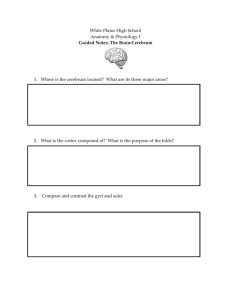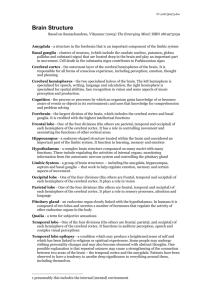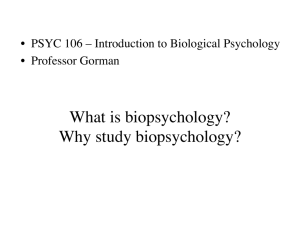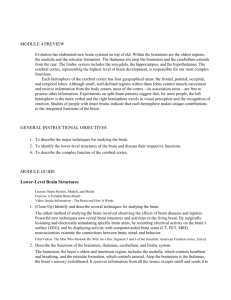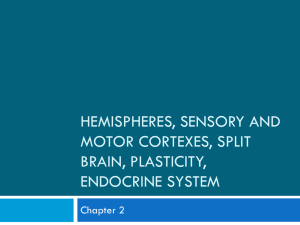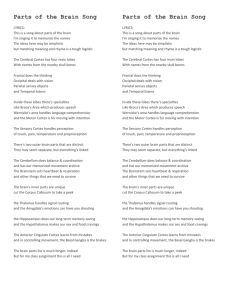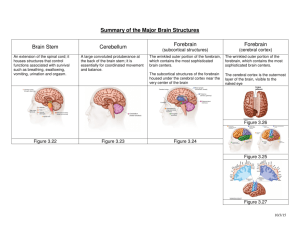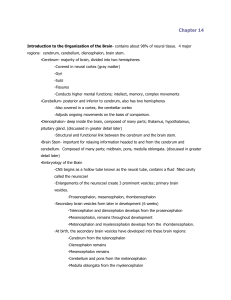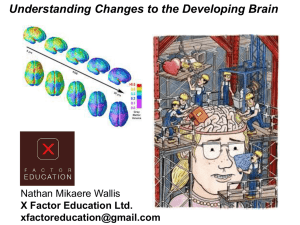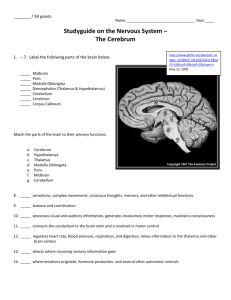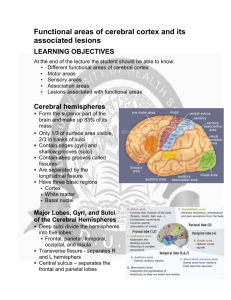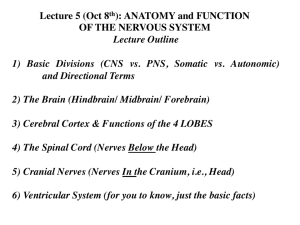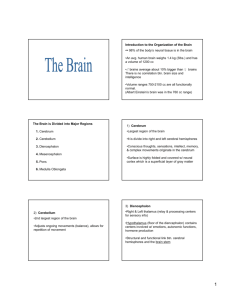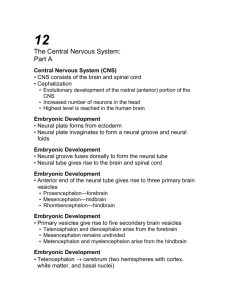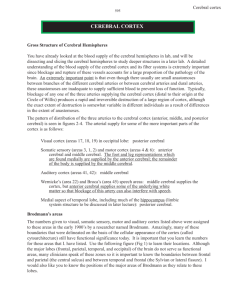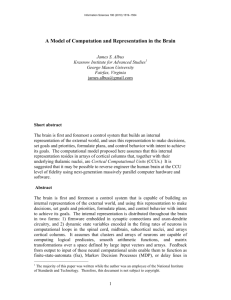Chapter 3c
advertisement
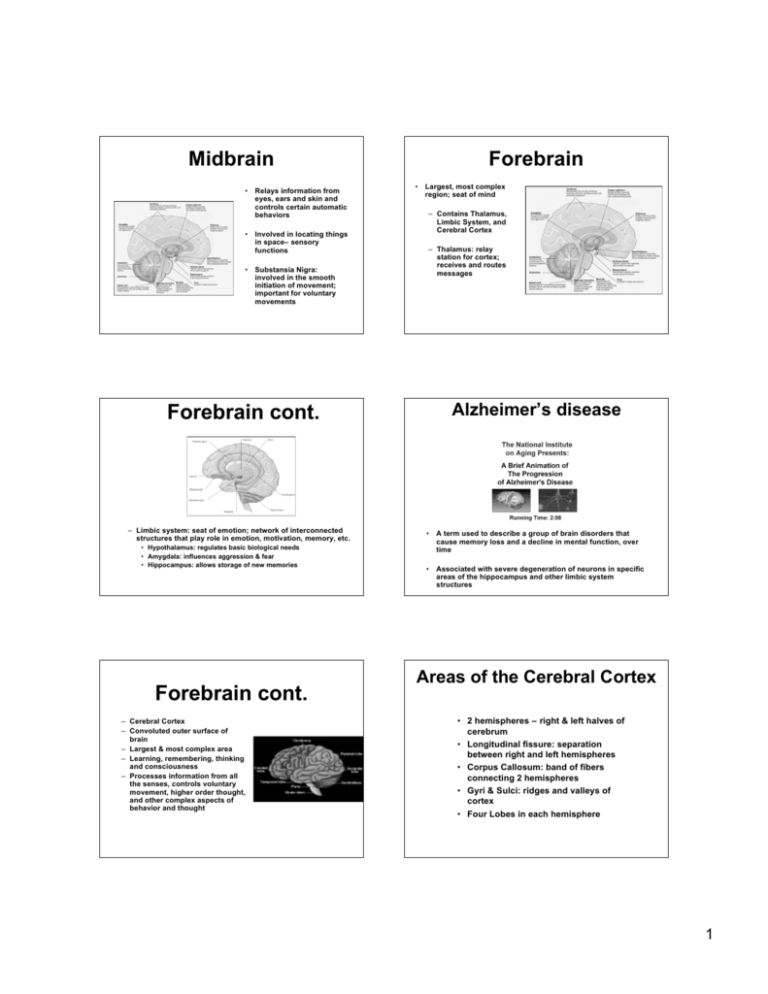
Midbrain • • • Relays information from eyes, ears and skin and controls certain automatic behaviors Involved in locating things in space– sensory functions Substansia Nigra: involved in the smooth initiation of movement; important for voluntary movements Forebrain • Largest, most complex region; seat of mind – Contains Thalamus, Limbic System, and Cerebral Cortex – Thalamus: relay station for cortex; receives and routes messages Alzheimer’s disease Forebrain cont. – Limbic system: seat of emotion; network of interconnected structures that play role in emotion, motivation, memory, etc. • Hypothalamus: regulates basic biological needs • Amygdala: influences aggression & fear • Hippocampus: allows storage of new memories Forebrain cont. – Cerebral Cortex – Convoluted outer surface of brain – Largest & most complex area – Learning, remembering, thinking and consciousness – Processes information from all the senses, controls voluntary movement, higher order thought, and other complex aspects of behavior and thought • A term used to describe a group of brain disorders that cause memory loss and a decline in mental function, over time • Associated with severe degeneration of neurons in specific areas of the hippocampus and other limbic system structures Areas of the Cerebral Cortex • 2 hemispheres – right & left halves of cerebrum • Longitudinal fissure: separation between right and left hemispheres • Corpus Callosum: band of fibers connecting 2 hemispheres • Gyri & Sulci: ridges and valleys of cortex • Four Lobes in each hemisphere 1 Cerebral Cortex Cerebrum: lobes cont. • Temporal –primary auditory cortex – Also assists with memory, especially visual memory & language comprehension • Frontal – Speech, reasoning, emotions, executive functions, & primary motor cortex Right Brain/Left Brain Lateralization • Most sensory and motor pathways cross over as they enter and leave the brain • Left hemisphere receives information and controls the right side of the body and vice versa Cerebrum: lobes • Occipital – primary visual cortex – Beginning of visual processing; info on size and color of things • Parietal – primary sensory cortex (also lies in occipital and parietal) – Somatosensory cortex: receives info from the skin about touch, pain and temperature Other areas of Cortex • Motor cortex mirrors the somatosensory cortex – Example: facial movement area of brain is close to the facial sensory area • Association areas: 3/4ths of cerebral cortex for integrating information & not responsible for any specific sensory or muscular function Right/Left Brain Lateralization • • Two halves connected by the corpus callosum; each side of the brain shares info with the other Each hemisphere specializes – Left hemisphere – verbal processing: language, speech, reading, writing – Right hemisphere – nonverbal processing: spatial, musical, visual recognition 2 Split brain research • Split-brain surgery: severing of corpus callosum (e.g., to control for seizure when severe disorder) • Discovered each hemisphere of brain has specialized functions (left - language & right - spatial skills) • Usually both sides of brain work together • What happens if split? Chemistry of Psychology Split Brain • Video Neurotransmitters & their functions Neurotransmitter Function Malfunction Example Acetylcholine (ACh) Movement and memory Undersupply marks Alzheimer’s Dopamine (DA) Influences movement and reward Excess linked to schizophrenia; inadequate DA Parkinson’s Disease Norepinephrine Arousal, mood, sleep, learning Undersupply linked to depression Serotonin Affects mood, hunger, sleep and arousal Undersupply linked to depression • Neurotransmitters revisited • More than 100 different NTs have been discovered – 3 main categories: small molecules, peptides and gases – Small molecules and 1 peptide - our focus • Small molecule NTs occur in CNS and PNS Neurotransmitters A peptide NT: Endorphins • Video • How endorphins were discovered • Candace Pert: why would the brain be equipped to process morphine UNLESS the nervous system had its own counterpart to morphine • Produced in response to pain and vigorous exercise 3 Endocrine System • Cells of endocrine organs, or glands, communicate by secreting chemicals called hormones – chemical messengers secreted by glands into the bloodstream – Affect target organs throughout the body – Example: estrogen and androgens • Pituitary – “master gland” – Stimulates action of other endocrine organs throughout the body Figure 3.18 The endocrine system. The endocrine glands secrete hormones into the bloodstream. These hormones regulate physical functions and may affect behavior. 4


